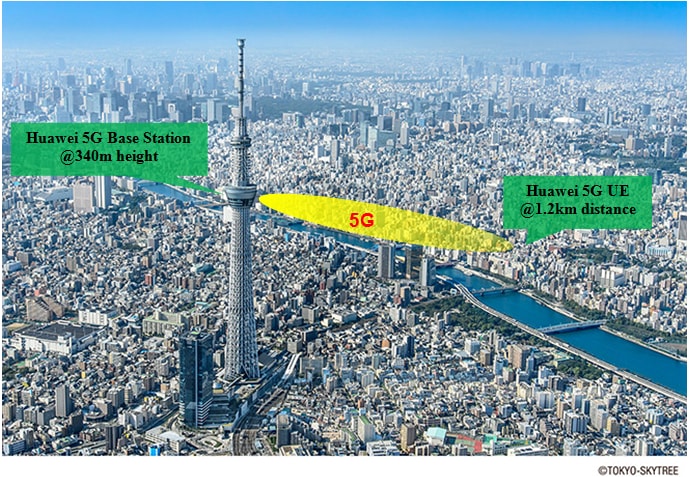NTT Docomo
NTT DOCOMO & SK Telecom Release White Papers on Energy Efficient 5G Mobile Networks and 6G Requirements
- Possibilities to achieve greater energy savings based on energy consumption levels measured in the two companies’ respective base stations
- Technical analysis of candidate energy-saving technologies, including both hardware and software
- The roles that operators and equipment vendors should play, including the need for greater coordination, in the effort to achieve greater energy savings
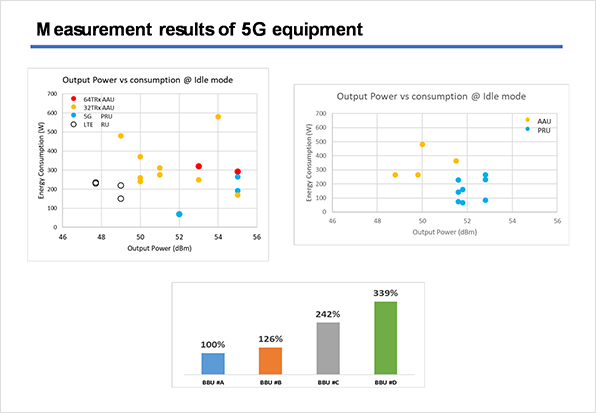
For 6G, the paper reviews requirements and challenges including specific performance levels and implementation scenarios, focusing on technical issues of particular importance to mobile operators:
- Performance requirements and implementation scenarios for each frequency band, taking into account the characteristics of each frequency
- Issues concerning coverage and devices in high-frequency bands
- Standardization for migration to 6G architecture and application of cloud-native / open architecture
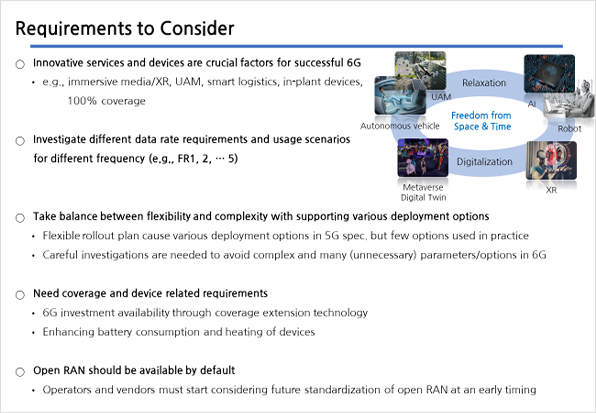
Going forward, NTT DOCOMO and SKT will continue to collaborate in various technical fields, aiming to enhance the competitiveness and operational efficiency of 5G as well as support the global standardization and technical verification of 6G. They will also collaborate with global telecom operators on 6G standardization and R&D with the goal of building a global ecosystem that encompasses advanced industries and technologies.
“The white papers carry a significant meaning as they mark the first tangible result since entering into a strategic partnership with NTT DOCOMO last year,” said Yu Takki, Vice President and Head of Infra Tech Office of SKT. “Based on our experience and knowhow in 5G, we will continue to collaborate with world-leading operators such as NTT DOCOMO to lead 5G evolution towards 6G.”
Takehiro Nakamura, Chief Technology Architect, NTT DOCOMO, said: “We are delighted to jointly announce two white papers on green mobile networks and 6G requirements as our collaborative achievements with SKT started in November 2022. We will continue to enhance cooperation among the two major Asian mobile operators and promote superior concepts and innovative technologies to the world for the 6G deployment.”
NEC and Cisco in Global Systems Integrator Agreement for 5G IP Transport
NEC Corp and Cisco today announced they have entered into a Global System Integrator Agreement (GSIA) to expand their partnership for accelerating the deployment of innovative 5G IP transport network solutions worldwide.
[Will any other protocol besides IP operate over 5G data plane?]
Under the agreement, the companies will jointly drive new business opportunities for 5G. NEC group companies will work closely with Cisco to complement NEC’s ecosystem with optimized IP metro/access transport and edge cloud computing solutions. Cisco will support NEC’s customer engagements by offering best-in-class products, proposals and execution support.
The new agreement underlines NEC’s successful track record as a Cisco Gold Partner over two decades, and its proven engineering capabilities to provide Cisco products to its global customer base across multiple regions.
“We believe 5G is fueling the internet for the future, and accelerating our customers’ digital transformations,” said Jonathan Davidson, Senior Vice President and General Manager, Mass-Scale Infrastructure Group, Cisco. “Together with NEC, we are creating a powerful force to drive the critical changes needed in networking infrastructure to carry the internet into the next decade.”
“Collaboration across the network solution ecosystem is essential for continued success in meeting diversified customer requirements and establishing a win-win relationship,” said Mayuko Tatewaki, General Manager, Service Provider Solutions Division, NEC Corporation. “This powerful partnership strengthens our global competitiveness as a network integrator that drives the customer journey with innovative solutions.”
NEC and Cisco say they will make collaborative efforts to further enhance their joint solution portfolio and to optimize regional activities for advancing the digital transformation of customers across the globe. Indeed, NEC has a long history of working with Cisco stretching back more than two decades. This includes the two working together on 4G LTE equipment that combined NEC’s RAN and backhaul assets with Cisco’s network equipment.
The two firms last year bolstered efforts in ensuring the security of their networking equipment. This involved using NEC’s blockchain technologies and Cisco’s fraud detection technologies to confirm the authenticity of network equipment used for security and critical industrial infrastructure before it was shipped to a customer, during the construction of those networks, and during operation.
NEC also participated in Rakuten Mobile’s 4G-LTE network deployment in Japan. NEC has so far gained the most from that deployment as it’s been tapped to provide a standalone (SA) 5G core network based on the specification it wrote with Rakuten Mobile.
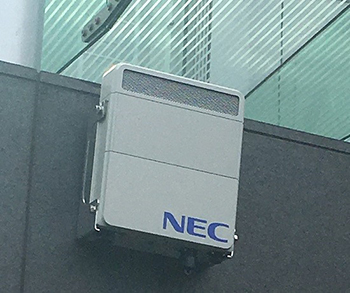
NEC recently established an Global Open RAN Center of Excellence in the UK, which aims “to accelerate the global adoption of Open RAN and to further strengthen its structure for accelerating the global deployment of 5G.”
The company also developed (with Samsung) and demonstrated an O-RAN Alliance compliant 5G base station baseband unit (5G-CU/DU) on NTT DOCOMO’s commercial 5G network.
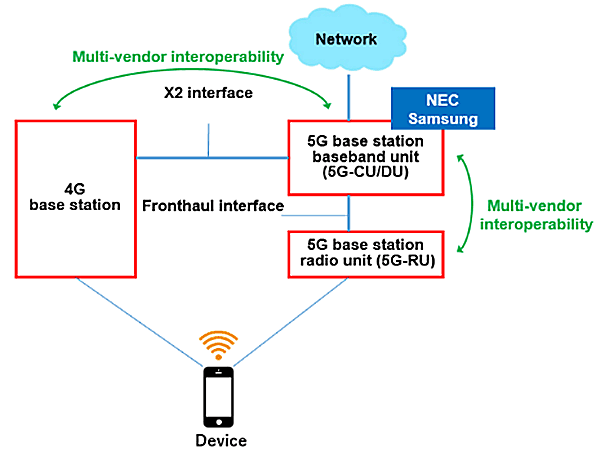
Source: NEC Corp.
………………………………………………………………………………………………………………………………….
Cisco was initially part of Rakuten Mobile’s 4G-LTE deployment, but has been conspicuously absent from the Japanese carrier’s more recent 5G plans. Cisco has been steadily bolstering its 5G focus with updates to its routing and networking equipment. This includes updates earlier this year to its router portfolio, and scoring a deal late last year with AT&T to assist with disaggregated IP routing technology for an edge routing platform.
Cisco has also been working with Japanese carrier KDDI on its 5G and network virtualization efforts. This included a proof-of-concept (PoC) last year that demonstrated cloud-native software with Cisco’s Ultra Packet Core platform.
Nonetheless, Cisco continues to lag behind the more established telecom vendors in providing 5G equipment. They don’t make cellular base stations which limits their offerings to routers with 5G interfaces.
A recent Dell’Oro Group report placed Cisco a distant No. 5 among overall telecom equipment vendors, with its market share having shrunk by 1% from 2019 to 2020 to only 6%.
| Top 7 Suppliers | Year 2019 | Year 2020 |
| Huawei | 28% | 31% |
| Nokia | 16% | 15% |
| Ericsson | 14% | 15% |
| ZTE | 9% | 10% |
| Cisco | 7% | 6% |
| Ciena | 3% | 3% |
| Samsung | 3% | 2% |
Source: Dell’Oro Group
………………………………………………………………………………………….
References:
https://www.nec.com/en/press/202104/global_20210408_01.html
https://www.sdxcentral.com/articles/news/cisco-nabs-nec-to-expand-5g-reach/2021/04/
https://www.delloro.com/key-takeaways-total-telecom-equipment-market-2020/
AT&T Announces 5G Roaming in Japan when 5G roam-capable devices are available
AT&T 5G customers will be the first U.S. mobile customers to have the ability to access 5G in Japan through an international roaming agreement with NTT DOCOMO, Inc. and by using a 5G roam-capable device – the first of which will become available on the AT&T network this week.
The agreement delivers on AT&T’s commitment to keeping its customers connected and providing them with access to 5G – at home and around the globe – as capable devices become available. However, this agreement is only for 5G NSA which uses an LTE anchor/core for all non-RAN related functions.
“As a longtime industry leader providing global connectivity, we’re evolving the breadth and depth of our global coverage with 5G,” said Susan A. Johnson, executive vice president – Global Connections & Supply Chain, AT&T. “This marks a significant milestone for AT&T and our customers.”
AT&T customers on a wireless plan that includes access to 5G in the U.S. will be able to access 5G in Japan through NTT DOCOMO, Inc., when they use a 5G roam-capable device.
But what are those 5G roam-capable devices and when will they be available? They will surely be based on 3GPP Release 15 5GNR for the data plane, and 4G LTE for everything else, e.g. signaling, network management, security, 4G core/EPC, etc. Hence, this arrangement might be called “5G NSA roaming with a LTE core network/EPC.” 5G SA roaming will be much more complicated as there is no standard for 5G core network and all the “cloud native” functions (like network slicing and virtualization) it will support.
“We’re excited to launch 5G roaming in Japan on NTT DOCOMO, Inc.’s network because of what it means for our customers,” said JR Wilson, vice president – Tower Strategy & Roaming, AT&T. “Our teams never stop innovating, developing and deploying the latest technology to provide our customers with access to a next-generation network – at home and abroad.”

AT&T claims they have historically been a leader in global roaming. So, while the company continues innovating to enable customers with compatible devices to access 5G internationally, those with LTE devices can still expect the same great roaming coverage they’re used to while traveling.
NTT DOCOMO is the first mobile operator in Japan to offer an inbound 5G roaming service. Going forward, DOCOMO plans to expand its inbound 5G roaming service with mobile operators around the globe. Again, that will surely be for 5G NSA service.
References:
https://www.nttdocomo.co.jp/english/info/media_center/pr/2020/0914_00.html
Addendum: 5G SA roaming will be much more difficult
Roaming with a 5G SA endpoint device (smartphone, tablet, notebook PC, robot/industrial equipment, etc. won’t be achieved anytime soon. Why? There is no standard for 5G core network which have to interoperate with one another for roaming.
The 3GPP core network specs are architecture documents that do NOT specify implementation details. Therefore, every 5G network provider will have its own 5G core spec which is implemented in the core network routers/compute servers and endpoints. So each 5G endpoint (e.g. smartphone or tablet/notebook PC) will have to download a 5G SA software update from the 5G network provider. That means that unless there are bilateral 5G carrier roaming agreements, a 5G end point can only work on the 5G core network it’s subscribed to, e.g. no portability or interoperability!
3GPP Rel 16 5G Core/Architecture specs:
- TS 23.501 5G Systems Architecture, with annexes which describe 5G core deployment scenarios:
- TS 23.502 [3] contains the stage 2 procedures and flows for 5G System
- TS 23.503 [45] contains the stage 2 Policy Control and Charging architecture for 5G System
………………………………………………………………………………………………………………………………………………….
NTT DoCoMo achieves multi-vendor 4G/5G RAN using O-RAN specifications
NTT DoCoMo has announced that it has achieved multi-vendor interoperability across a variety of 4G and pre-standard 5G base station equipment from Fujitsu, NEC and Nokia. Equipment from those vendors supports the Open Radio Access Network (O-RAN) Alliance specifications, which are NOT standards as claimed in DoCoMo’s press release. This is believed to be the world’s first realization of this level of multi-vendor interoperability in 4G and 5G base station equipment conforming to O-RAN specifications.
Up until now, cellular telcos (cellcos) have been locked into single cellular base station vendor contracts when deploying their radio access networks (RANs). Despite ITU-R standardization and 3GPP specifications, operators have not been able to use one vendor’s baseband gear with another’s radio equipment. Working across different 4G and 5G vendor systems has been similarly problematic if not impossible. Critics say this interoperability dilemma has led to “vendor lock-in” and strengthened a small number of giant RAN vendors, namely Ericsson, Huawei and Nokia.
The Open Radio Access Network (O-RAN) Alliance wants to change that. It is an operator led industry group working to create more open and intelligent next generation radio access networks, including 5G networks. The O-RAN specifications include RAN fronthaul and X2 profiles. There are 21 network operator members shown on the O-RAN Alliance member list, which includes NTT DoCoMo, AT&T, Verizon, Deutsche Telekom, Orange, China Mobile, China Telecom and other tier 1 operators.
RAN fronthaul describes the connectivity between remote base stations and centralized cell units, enabling multiple remote units to be serviced by a single central baseband unit using open hardware specs. Ultimately, radio heads and baseband units may be mixed and matched to create a fully multi-vendor RAN.
The ability to deploy and interconnect base station equipment from different vendors will make it possible to select the equipment most suitable for deployment in any given environment, such as base stations offering broad coverage in rural areas or small base stations that can be deployed in urban areas where space is limited. This will in turn allow more rapid and flexible expansion of 5G coverage.
DoCoMo will deploy the equipment in the pre-commercial 5G service it plans to launch on September 20, 2019 in Japan. Concurrent with the pre-commercial launch of its 5G services, DoCoMo will expand 5G coverage by combining 5G networks with existing 4G networks using equipment from diverse vendors. The signal transmission specifications that will enable this follows lengthy discussions within the O-RAN Alliance, which DoCoMo is chairing.
4G and 5G multi-vendor interoperability:
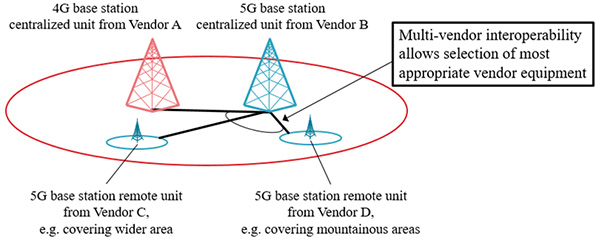
O-RAN fronthaul interface specifications provide a foundation for interoperability between centralized units and remote units of 5G remote-installed base stations manufactured by diverse partners. With remote-installed base stations, centralization of the baseband processing will bring the following benefits:
- Improved communication quality through coordination of multiple remote units
- Pooling of resources through the aggregation of hardware
- Minimization of equipment footprint, leading to a reduction in space and costs.
In addition, through the provision of only radio processing, the remote unit can be further downsized, making it possible to install in a variety of locations that would previously have not been viable, such as small buildings or mountainous areas.
The O-RAN X2 profile specifications provide a foundation for interoperability between 4G base stations and 5G base stations manufactured by diverse partners in 5G non-standalone (5G NSA) networks by taking 3GPP X2 interface specifications and specifying details for their usage. 3GPP Release 15 based 5G NR-NSA networks connect devices using both 4G and 5G technologies. The connection of 4G and 5G base stations makes it possible to combine the high-speed, low-latency data communications delivered by 5G technology with the comprehensive coverage of 4G networks.
Going forward, DoCoMo will continue to refine and develop its cutting-edge base station communication technology, aiming to expand the provision of stable 5G coverage.
………………………………………………………………………………………………………………………………………………………………………………………….
Open Test and Integration Center (OTIC):
O-RAN has announced the Open Test and Integration Center (OTIC) – an initiative led by China Mobile and Reliance Jio along with participation from China Telecom, China Unicom, Intel, Radisys, Airspan, Baicells, CertusNet, Mavenir, Lenovo, Ruijie Network, Inspur, Samsung Electronics, Sylincom, WindRiver, ArrayComm, and Chengdu NTS.
The above named companies are collaborating on multi-vendor interoperability and validation activities for O-RAN compliant 5G access infrastructure. The initial focus is to ensure RAN components from multiple vendors support standard and open interfaces and can interoperate in accordance with O-RAN test specifications.
“China Mobile will initiate an OTIC in Beijing, China, which should provide the common platform for solutions to be operationally ready to enable end-to-end interoperability and deployment in scale; as well as to be hardened for reliability, performance, scalability, and security that operator networks require,” said Dr. Li Zhengmao, EVP of China Mobile.
“Jio is creating an OTIC to accelerate the telecom industry transformation by driving ready-for-commercialisation products and solutions,” said Mathew Oommen, President, Reliance Jio.
………………………………………………………………………………………………………………………………………………………………………………………….
Heavy Reading Comments:
“It is pretty significant for O-RAN because DoCoMo is a genuinely leading operator, a rainmaker in these things,” says Gabriel Brown, a principal analyst with Heavy Reading. “They have said this will conform with O-RAN specifications in what looks like the production 4G and 5G network.”
“One of the criticisms of the 5G RAN was about using the same 4G vendor, but the implication here is that you could do multivendor,” said Brown, pointing to NTT DoCoMo’s statements about the O-RAN Alliance’s X2 specifications. “What they don’t appear to be saying is that they have different baseband vendors for 4G and 5G, but they are saying they can do it. There is no question at all this is a big statement about O-RAN.”
NTT DoCoMo’s update is not a complete surprise, he says, because the operator had already been in trials with Fujitsu, NEC and Nokia. Today’s move aligns that model with the O-RAN specifications at an important moment. “Whatever they are doing has to be rock solid because the Rugby World Cup is coming in a couple of weeks,” says Brown. “That is a warm-up for the 2020 Olympics in terms of international attention on Japanese networks and all operators will be launching a limited 5G service.”
……………………………………………………………………………………………………………………………………………………………………………………
Telco Testimonials and Deployment Plans for O-RAN:
“ The O-RAN Alliance was created to accelerate the delivery of products that support a common, open architecture and standardized interfaces that we, as operators, view as the foundation of our next-generation wireless infrastructure, while ensuring a broad community of suppliers driven by innovation and open market competition. ” — Alex Jinsung Choi, SVP Research and Technology Innovation, Deutsche Telekom “ Our industry is approaching an inflection point, where increasing infrastructure virtualization will combine with embedded intelligence to deliver more agile services and advanced capabilities to our customers. The O-RAN Alliance is at the forefront of defining the next generation RAN architecture for this transformation. ” — Andre Fuetsch, CTO and President AT&T Labs.
AT&T is a key proponent of O-RAN adoption. An AT&T employee, who presented on O-RAN at ONF Connect 2019, said the company is seriously evaluating adopting the Alliance’s specifications for 5G deployments sometime in 2020. AT&T has said that it foresees that it can bring the “whitebox” environment to the RAN by adopting open hardware specifications.
……………………………………………………………………………………………………………………………………………………………………………………
References:
https://www.nttdocomo.co.jp/english/info/media_center/pr/2019/0918_00.html
https://www.o-ran.org/membership
https://www.o-ran.org/specifications
http://the-mobile-network.com/2019/03/taking-the-open-ran-commercial/
NEC Demo’s Face Recognition Using MEC to NTT DOCOMO 5G Open Lab
In order to optimize bandwidth, monitoring cameras can stream low definition images when people are not detected, and high definition images when certain behaviors are detected. The demo system consists of NEC’s face recognition AI engine NeoFace, Image Analysis and Behavior Detection System and Context-aware Service Controller solutions. They are installed on MEC servers and connected through a virtualized evolved packet core.
“NEC will continue to develop and offer a variety of solutions as a top vendor of domestic mobile core networks in the 5G era and to contribute to the expansion of the DOCOMO 5G Open Partner Program, while taking advantage of our experience and knowhow,” NEC GM for network solutions Kazuhiro Tagawa said.

This announcement includes part of the results of a research project “Research and development for the achievement of a fifth-generation mobile communication system – Research and development of high-speed and low-power consumption wireless access technology utilizing a super multi element antenna with high-frequency and large bandwidth” commissioned by the Ministry of Internal Affairs and Communications.
The NTT DOCOMO 5G Open Lab OKINAWA provides charge free technical verification environments, including 5G base stations, for companies and groups participating in the DOCOMO 5G Open Partner Program. The lab aims at creation of new use cases for 5G, promotion of local industries and resolution of social issues in Okinawa. NEC has provided 5G base stations utilizing 4.5 GHz frequency band to this lab.
References:
https://www.acnnewswire.com/press-release/english/49108/
https://www.nec.com/en/global/solutions/safety/face_recognition/index.html
NEC Contact: Seiichiro Toda [email protected] +81-3-3798-6511
5G Trials in Singapore, Guam and Hong Kong
Nokia and StarHub complete “5G” New Radio pilot in Singapore
Singapore network operator StarHub and Nokia have conducted what they claim was the first outdoor live network demonstration of “5G” New Radio (NR) on the 3.5GHz frequency band in the Asian city-state.
The companies said two use cases were demonstrated to staff, industry partners and enterprise customers over ‘live’ Nokia 5G cells and core network technology at StarHub’s headquarters in Singapore.
The first use case demonstration for industrial applications replicated a manufacturing environment, demonstrating how businesses can use 5G-enabled video analytics to enhance efficiency and reduce production errors.
The use case for consumers demonstrated how sports fans can use a 5G-enabled virtual reality headsets to have immersive video experience of “live” sports events.
The trial was conducted in a 5G non-standalone network architecture, with Nokia 5G radio technology interworking with StarHub’s 4G core network.
Nokia deployed AirScale Radio Access technology with 5G NR 3GPP-compliant software and the Nokia AirFrame data center solution.
“As 5G inches closer, we are intensifying trials to identify new business opportunities and chart our network transformation roadmap to meet the demands of our customers,” said Chong Siew Loong, chief technology officer of StarHub.
“This successful pilot with Nokia showcases the readiness and possibilities of 5G to enhance consumer services and boost efficiencies for enterprises. It aligns with StarHub’s goal to support and accelerate Smart Nation initiatives in Singapore.”
https://www.telecomasia.net/content/starhub-nokia-trial-5g-35ghz-band
………………………………………………………………………………………
NTT Docomo to establish 5G test lab in Guam
The facility, Docomo’s first overseas verification center, will allow Docomo’s Program partners to connect devices and services free of charge to the lab’s 5G base and mobile stations and related equipment.
The test environment will subsequently be extended to outdoor locations to allow verification testing in real-world outdoor environments.
The facility’s location in Guam will allow for testing according to US-market technical and regulatory conditions.
With the initiative, Docomo aims to allow for prompt, flexible and accurate verification of equipment, systems and technologies for applications such as drones and autonomous vehicles.
Docomo’s 5G Open Partner Program is designed to provide global businesses and organizations with the latest 5G information, test environments and opportunities for partner workshops. The partner program currently has more than 1,900 members.
Docomo already operates 5G open labs in Seoul, South Korea and Osaka, Japan. The telco plans to open a third domestic lab in Okinawa, Japan next month.
………………………………………………………………………………………….
DOCOMO PACIFIC
A wholly-owned subsidiary of Japan telecommunications giant, NTT DOCOMO, DOCOMO PACIFIC was originally a merger of Guamcell Communications and HafaTel prior to acquisition in December 2006 by NTT DOCOMO. This acquisition allowed NTT DOCOMO the opportunity to share its world-leading technology with the region as evidenced by significant investments and upgrades in DOCOMO PACIFIC. In October 2008, DOCOMO PACIFIC was first on Guam to introduce the fastest and only 3.5G network. In November 2011, DOCOMO PACIFIC launched 4G HSPA+ service on Guam followed by the launch of advanced 4G LTE service in October 2012.
On 22 May 2013, DOCOMO PACIFIC officially merged with MCV Broadband and is now Guam and the CNMI’s leading provider of telecommunications and entertainment services. With combined offerings to include the latest mobile services, television, internet and telephone services in the region, DOCOMO PACIFIC continues to enhance the diversified range of services available to its customers.
https://www.telecomasia.net/content/docomo-establish-5g-test-lab-guam
https://www.docomopacific.com/about-us
…………………………………………………………………………………..
3HK completes Hong Kong’s first outdoor 5G trial
3 Hong Kong has revealed it has completed of 5G outdoor network trials in the 3.5-GHz and 28-GHz spectrum bands.
The company said it believes it was the first mobile operator in Hong Kong to complete a live outdoor 5G trial broadcast. The test was conducted at a trial cell site in Causeway Bay.
3 Hong Kong received an indoor 5G test permit for the 3.5-GHz band in August 2017, and completed a number of initial trials by the end of that year. In May, the company secured a temporary permit to conduct 5G trials in the 26-GHz and 28-GHz millimeter wave bands.
Another temporary permit for outdoor and indoor trials in the 3.5-GHz band was granted in June, and the company achieved 2Gbps network speeds during an earlier trial using 100MHz of spectrum in this band.
3 Hong Kong said the test results indicate that 3.5-GHz band coverage – when used in conjunction with Massive MIMO, can be comparable to the coverage afforded over LTE using the 1800-MHz band.
The design of 5G networks will use a combination of mid-band spectrum such as 3.5-GHz for a wider coverage area, and millimeter wave spectrum for high speeds
“3 Hong Kong took the initiative to carry out end-to-end trials in various 5G bands in preparation for a new era of mobile communications,” commented Kenny Koo, CEO of 3 Hong Kong’s parent company Hutchison Telecommunications Hong Kong Holdings.
“We welcome the government’s decision to allow various of its premises to accommodate 5G base stations, and we hope the application and approval processes can be simplified and accelerated to help Hong Kong’s 5G development.”
First published in Computerworld Hong Kong
NTT DoCoMo achieves 28GHz wireless data transmission in ultrahigh mobility environment
NTT DoCoMo says it has achieved what is believed to be the world’s first successful 28 GHz wireless data transmission between a 5G base station and a 5G mobile station in 5G field trials using a car moving at 305 KMH or about 189 MPH. The trials were conducted last month at the Japan Automobile Research Institute (JARI) using 700 megahertz of spectrum. They also included live wireless relay of 4K high-frame rate video via uplink from a 5G mobile station moving at 200 km/h, according to DoCoMo.
The speeds in the field trials are designed to be similar to speeds of high-speed railways, so it’s understandable the operator wants to make sure it works, including handoffs, at these kinds of speeds.
Working with NEC and Nippon Telegraph and Telephone Corporation (NTT), DoCoMo said the trials also achieved what are believed to be the world’s first successful 1.1 Gbps ultrahigh-speed data transmission via downlink to a 5G mobile station moving at 293 km/h. It also conducted a fast handover during communication between 5G base stations and a 5G mobile station moving at 290 KMH.
DoCoMo noted that the “world’s first” achievements are according to DoCoMo research as of April 23, 2018. Japan’s largest wireless network operator and its partners used beamforming and beam tracking to address propagation challenges in the 28 GHz band. The 5G base stations used massive-element antenna (96 elements, up to two beams), and the mobile station had massive-element antenna (64 elements, up to two beams). Sony Business Solutions provided a 4K camera for high-frame rate video, and DoCoMo’s own Dandelion racing manager provided a trial car and operated the car on the test course.
…………………………………………………………………………………………………………………………………………………………..
DoCoMo’s 5G R&D objectives and “Phantom Cell” architecture:
NTT DOCOMO’s 5G related research and development will enable a wide range of capabilities such as super high data rate communications of over 10Gbps, lower latency, and simultaneous connection of a large number of terminals in order to support the future spread of M2M communications and internet of things (IoT), etc.
DOCOMO is advocating the concept of Phantom Cell architecture, which consists of a combination of a small cell using a higher frequency band and broader bandwidth and a macro cell using a conventional lower frequency band. For 5G, DOCOMO is making research and development efforts with a focus on the development of technologies that enable efficient transmission in higher frequency bands such as the beamforming technology leveraging a large array of antenna elements (Massive MIMO) as well as technologies for efficient transmission in lower frequency bands.
Toward the goal of 5G service rollout, various mobile communication technologies and schemes need to be tested, including low-latency transmission methods that meet the needs of M2M and other various applications. To this end, DOCOMO is conducting experimental trials in collaboration with world-leading vendors to confirm the feasibility of a wide range of mobile communication technologies, centering on the concepts that DOCOMO advocates.
…………………………………………………………………………………………………………………………………………………………..
DoCoMo is preparing to show off its 5G technology for the Olympics in 2020. Intel revealed earlier this year that it is collaborating with DoCoMo to develop 5G applications, like 360-degree 8K-video streams for highly immersive watching of the games.

Sports viewing: Choosing any of video streams from numerous small cameras in the venue, you can enjoy vivid, powerful images from the players’ viewpoints over an omni-directional three dimensional screen.
…………………………………………………………………………………………………………………………………………………………………
Earlier this year, DoCoMo completed a trial with Huawei and Tobu Railway at Tokyo Skytree Town, the commercial center in the Sumida District of Tokyo that is the home of the iconic 634-meter high television broadcasting tower and landmark. The trial focused on delivering consistent 5G system performance for enhanced mobile broadband (eMBB) applications within the complex, and was used to research radio propagation characteristics and other technical conditions for the 28 GHz band and other candidate spectrum within congested environments.
References:
https://www.nttdocomo.co.jp/english/info/media_center/pr/2018/0509_00.html
https://www.nttdocomo.co.jp/english/corporate/technology/rd/tech/5g/
https://www.nttdocomo.co.jp/english/corporate/technology/rd/tech/5g/5g_trial/index.html
Huawei and NTT Docomo “5G” mmWave Field Trial in Tokyo
Huawei is highlighting a Tokyo, Japan trial in which the Chinese telecom/IT vendor achieved “5G” like download speeds of 4.52 gigabits per second over ~ three-quarters of a mile using 28 GHz millimeter-wave wireless technology. The trial took place in downtown Tokyo, where a base station working over 28GHz frequency was located at Tokyo Skytree’s viewing deck, 340m above the city.
Working with Japan’s NTT Docomo, Huawei said it was confident of launching a commercial 5G rollout by 2020 (NOTE: the IMT 2020 set of 5G standards are to be finalized by year end 2020).
“The high-speed and long distance support is one of important technical challenges for 5G mmWave conditions. This successful long distance live-demo on a 5G mmWave is a groundbreaking achievement in our joint effort with NTT DOCOMO to build a fundamental 5G commercial environment. This success makes us more confident in realizing the goal of commercializing 5G by 2020,” said Gan Bin, vice president of Huawei’s 5G product line.
Huawei utilized its 5G base station for the test, which supports Massive MIMO and beam forming technologies. Huawei also provided the 5G core network and the 5G mm wave test user equipment.
Huawei anticipates conducting further testing at the world’s biggest 5G testing site in Beijing’s Huairou District.
The test comes amid a flurry of 5G testing and trials around the world. For example, BT and Nokia announced plans for live “5G” tests in the UK earlier this month.
References:
http://www.huawei.com/en/news/2017/12/NTT-DOCOMO-5G-mmWave-Field-Trial-Tokyo
https://www.totaltele.com/498823/5G-testing-spurs-Huawei-to-deliver-5G-by-2020


